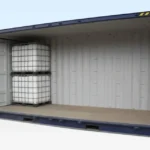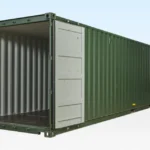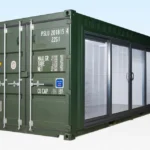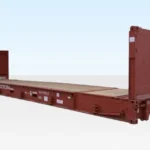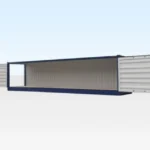Die Versanddokumente sollten nicht am physischen Transportbehälter befestigt werden, da sie beschädigt werden oder verloren gehen können.
Viele Dokumente werden heutzutage elektronisch erstellt, und es kann sein, dass es nicht notwendig ist, physische Papiere mit Ihrem Versandcontainer zu versenden. Ihr Spediteur oder Versandagent sollte in der Lage sein, Ihnen hier mit Ratschlägen speziell für Ihre Sendung zu helfen.
Allerdings werden die etablierten Verfahren in dieser Branche oft noch lange Zeit beibehalten, bis die ganze Welt auf neue elektronische Systeme umsteigen kann. Der Papierkram für Versanddokumente, die mit einem Exportcontainer verschickt werden müssen, läuft wie folgt ab.
- Nach der Beladung singen Sie alle relevanten Teile der Papiere ab (in manchen Fällen auch der Fahrer) und übergeben diese Papiere dem Lkw-Fahrer.
- Am Hafen übergibt der Fahrer diese Papiere an die Reederei. Normalerweise gibt es am Hafen für jede Reederei oder jeden Buchungsagenten ein Fach oder ähnliches.
- Der Hafen sammelt diese Papiere und sorgt dafür, dass sie mit dem Schiff mitgenommen werden.
- Bei der Ankunft werden die Container vom Schiff entladen, und die Papiere für die im Hafen ankommende Fracht werden dem Hafen übergeben.
- Der Ankunftshafen leitet dies dann an die Zollbeamten oder die zuständigen Personen am Zielort weiter.
Hermetisch versiegelte Versandcontainer werden oft nachgefragt, aber für die meisten Kunden (die meisten Budgets) ist es nicht möglich, einen hermetisch versiegelten Versandcontainer zu liefern.
Erstens haben alle Schiffscontainer eine kleine Anzahl von Entlüftungsöffnungen, um einen Luftstrom zu ermöglichen, wenn der Container von einem warmen in ein kühleres Klima umzieht, und um den Container atmen zu lassen, da sich die Luft im Inneren des Containers bei diesen Temperaturschwankungen ausdehnt und zusammenzieht.
Doch selbst wenn wir diese verschweißen, ist es nahezu unmöglich, eine wirklich luftdichte Abdichtung des restlichen Containers zu gewährleisten. Die Türdichtungen von Standardcontainern sind nicht hermetisch, und es wäre sehr schwierig, einen kleinen Luftspalt an einer anderen Stelle des Containers zu gewährleisten, vor allem, wenn er benutzt wird.
Kühlcontainer bieten die besten Chancen für eine wirklich luftdichte Abdichtung. Diese Einheiten haben einen dickeren Metallboden, keine Lüftungsschlitze und eine dickere Tür mit besseren Dichtungen. Wir sagen zwar, dass Sie sich nicht bei geschlossener Tür im Inneren aufhalten sollten, da Sie wahrscheinlich ersticken werden, aber wir können keine hundertprozentige Garantie für eine perfekte hermetische Abdichtung der Containertüren geben.
Wir sind uns bewusst, dass die Projekte und Anforderungen unserer Kunden oft einzigartig sind. Wenn Sie also ein spezielles Projekt oder eine "Herausforderung" haben, nehmen Sie Kontakt mit uns auf, denn ein kurzes Gespräch über Ihre Ideen kann uns oft helfen, Vorschläge und Empfehlungen zu machen.
Alle Standard-Schiffscontainer sind mit kleinen, ca. 1 Zoll großen, quadratischen Öffnungen an den oberen Schienen versehen. Diese lassen keinen nennenswerten Luftstrom zu, bedeuten aber, dass sie nicht luftdicht sind.
Bei einem gebrauchten Schiffscontainer kann es auch vorkommen, dass die Türdichtungen nicht in einwandfreiem Zustand sind, und auch kleinere Beschädigungen oder Verformungen des Bodens im Laufe der Zeit können dazu führen, dass ein winziges bisschen Luft durch den Boden strömen kann (obwohl dies unwahrscheinlich ist). Die Türdichtungen sollen nur verhindern, dass Wasserwellen durch die Türen eindringen und die Ladung im Inneren beschädigen, sie sind nicht dafür ausgelegt, luftdicht zu sein.
Kühlcontainer verfügen jedoch nicht über dieselben Entlüftungsöffnungen, sondern haben Metallböden, und wenn die Dichtungen vollständig intakt sind, sollten sie aus Gründen des Gesundheitsschutzes und der Sicherheit als luftdicht angesehen werden (z. B. Begrenzung der Zeit, die in einem geschlossenen Raum verbracht wird, oder Überwachungssysteme zur Kontrolle von Personen, die in einer solchen Umgebung arbeiten).
Verschleiß und Schäden an einem der Wärmetauscher im Motor des Kühlcontainers, Montageprobleme oder andere Schäden im Motorraum können dazu führen, dass die Kühlcontainer nicht mehr vollkommen luftdicht sind. Ähnlich wie oben beschrieben sind die Türdichtungen nicht speziell dafür ausgelegt, perfekt luftdicht zu sein, und bei einem gebrauchten Kühlcontainer können Abnutzungserscheinungen und teilweise Beschädigungen an der Dichtung auftreten.
Natürlich bieten wir für jeden von uns verkauften Versandcontainer standardmäßig unsere Wind- und Wasserdichtigkeitsgarantie an. Dies garantiert nicht, dass die Einheit luftdicht ist, und auch nicht, dass sie wasserdicht ist, wenn man den gesamten Container ins Meer wirft und erwartet, dass er schwimmt - wir garantieren lediglich, dass der von uns zum Verkauf angebotene Container Ihre Waren trocken und wettergeschützt hält, während er in einer statischen Lagerung vor Ort verwendet wird.
Wenn Sie auf der Suche nach einem Versandcontainer sind, können Sie gerne unseren Online-Katalog durchstöbern. Wir haben auch viele hilfreiche Tipps und Leitfäden in unserem News-Bereich, und Sie können uns natürlich kontaktieren, wenn Sie Fragen haben.
Schiffscontainer können als Schallschutzwand verwendet werden und bieten einen hervorragenden Schallschutz. Sie müssen sicherstellen, dass der Bereich, den Sie vor Lärm abschirmen wollen, durch die zu installierende Containerwand vollständig von einer potenziellen Lärmquelle abgeschirmt ist.
Sehen Sie sich unseren Artikel an, in dem wir 33x 40-Fuß-Schiffscontainer an Tottenham Hotspur als Teil der laufenden Stadionsanierung geliefert haben. Die Schiffscontainer wurden eingesetzt, um die Anwohner vor Staub und Lärm zu schützen, die von der Baustelle ausgehen.
Die gewellten Seitenwände tragen dazu bei, den Lärm abzuschirmen, und der Preis der Schiffscontainer macht dies zu einer sehr effektiven und attraktiven Option im Vergleich zu anderen Mitteln.
Wir haben in der Vergangenheit auch schon Schiffscontainer geliefert, um Landwirten zu helfen, die Anwohner vor Lärm und Staub aus Getreidesilos zu schützen. Es gibt viele mögliche Anwendungen für diese Art von Einsatz.
OOG ist eine Abkürzung für 'Out of Gague' - eine Terminologie, die verwendet wird, um eine Ladung zu beschreiben, die nicht in die ISO-Abmessungen eines Schiffscontainers passt, oder eine Ladung, die über diese Abmessungen hinausgeht.
Jede Ladung, die über die Standardabmessungen des jeweiligen Containertyps hinausgeht, wird als "außerhalb der Spurweite" eingestuft. Dazu gehören alle offenen Verdecke, bei denen die Ladung über die Dachlinie hinausragt, sowie alle Plattformen und flachen Gestelle, bei denen die Ladung über die Seiten, die Dachlinie oder die Enden des Containers hinausragt.
Auf alles, was wir verkaufen, gewähren wir eine 12-monatige Garantie auf Wind- und Wasserdichtigkeit, aber wir empfehlen Ihnen, sich darauf einzustellen:
Ein gebrauchter Schiffscontainer wird seit mehr als 10 Jahren gut genutzt (mit minimaler bis gar keiner Wartung).
Etwa die doppelte Lebensdauer eines (neuen) Schiffscontainers für eine Fahrt.
Dies ist unter anderem aufgrund der Bauweise eines Schiffscontainers möglich. (Gebaut aus COR-TEN-Stahl der Güteklasse A, der im Vergleich zu normalem Stahl sehr langsam rostet). Da unsere gebrauchten Schiffscontainer direkt aus dem Import stammen und vor dem Wiederverkauf immer in unseren britischen Depots überprüft und repariert werden, können Sie sicher sein, dass der Container bis zum Zeitpunkt des Verkaufs gut gewartet worden ist.
Bei jedem Container nutzen sich die Türscharniere und Dichtungen mit der Zeit ab. Der größte Faktor für die Abnutzung ist, wie oft der Container geöffnet und geschlossen wird. Wenn Sie häufig auf Ihren Container zugreifen, werden Sie feststellen, dass die Türdichtungen und Scharniere/Dichtungen schneller verschleißen. Diese können bei Bedarf ausgetauscht werden.
Ja, lautet die kurze Antwort.
Schiffscontainer sind stark, robust und billig. Sie können eine effektive Struktur für eine breite Palette von Gebäudeoptionen bilden. Es gibt eine Reihe von Beispielen auf der ganzen Welt für erfolgreiche Containerhäuser.
Es wurden zwar bereits Beispiele gebaut, aber sie sind noch weit davon entfernt, von der breiten Masse angenommen zu werden. Wenn Sie in Deutschland ein Haus aus Containern bauen wollen, sollten Sie sich zunächst eingehend über die örtlichen Bauvorschriften informieren.
Es gibt viele Online-Ressourcen, aber das ist noch ein relativ neuer Bereich im Bauwesen. Wir empfehlen im Allgemeinen, dass es eine sehr preiswerte Option für Selbstbauer sein kann, aber in diesem Stadium, wenn Sie einen Bauunternehmer mit dem Bau beauftragen, da es sich wahrscheinlich um ein neues Material handelt, mit dem sie keine Erfahrung haben, wird es wahrscheinlich keine signifikanten Einsparungen gegenüber einem traditionellen Gebäude geben.
The floor depths on a shipping container (the difference in height between the internal floor line and the bottom of the shipping container externally) can officially change a little between 2 different shipping containers. The reason for this – the eternal measurements on a container are tightly controlled by ISO regulations, but the internal dims are not restricted by international standards.
Standard 20ft, 40ft and 40ft high cube dry containers will all have a circa 6 inch (15cm) deep floor and although slight variations will be experienced – these will typically be minimal as large volume shippers expect to fit the same amount of their cargo into any shipping container of that size and type.
Open top containers, open sided containers and any container that might need extra rigidity in the floor as it might not have strength available in another panel will typically have thicker floors, circa 8-9 inches (20-23cm)
Flat rack and platforms which might also be rated well over 30 tonnes may have anything up to a 18-20 inch floor depth, (circa 50cm), as the entire strength of the container is supported by the floor
If you need to know the depths of a container floor that you are buying from us, let us know and we can send someone into the yard to physically measure and check your container for before delivery.
*Update* Ab Juli 2019 akzeptieren wir keine Kartenzahlungen mehr.
Ja, wir akzeptieren alle gängigen Kredit- und Debitkarten, jedoch nicht American Express.
Wir behandeln alle Kunden als "Nicht-Verbraucher", es sei denn, Sie verlangen ausdrücklich einen Verbraucherpreis (was ein neues Angebot zur Folge hat).
Standardmäßig wird ein Zuschlag von 2,75 % für Kreditkartenzahlungen erhoben, für Zahlungen mit Debitkarten wird kein Zuschlag erhoben.
Aus Gründen des Kartenbetrugs akzeptieren wir keine Kartenzahlungen von Karten mit registrierten Rechnungsadressen außerhalb des Vereinigten Königreichs, und wir akzeptieren normalerweise keine Kreditkartenzahlungen für Container, die für den Export verwendet werden.
Weitere Informationen hierzu finden Sie in unserem Blogbeitrag über Kreditkartenzuschläge.
Wenn der Container mit einem Schlosskasten (Vorhängeschlossabdeckung) und einem robusten Vorhängeschloss ausgestattet ist, muss man unserer Erfahrung nach entweder ein erfahrener Schlossknacker sein (ein qualitativ hochwertiges Vorhängeschloss ist selbst für einen Fachmann sehr schwer zu knacken) oder man benötigt eine schwere Schneidausrüstung, um die Seiten oder das Dach des Containers zu durchtrennen oder um das Schloss und die Vorhängeschlossabdeckung abzuschneiden (beides ist mit ähnlichem Aufwand verbunden).
Mit dem richtigen Handwerkszeug würde das wahrscheinlich Stunden dauern, und aus der Sicht eines potenziellen Kriminellen gibt es wenig bis gar keine Garantie dafür, dass sich in Ihrem Container etwas befindet, das sich zu stehlen lohnt.
Unser allgemeiner Rat: Ein Schließfach und ein qualitativ hochwertiges Vorhängeschloss schrecken den durchschnittlichen Kriminellen ohne Frage ab. Es ist einfach zu viel Aufwand, in einen Container einzubrechen, das Risiko, erwischt zu werden, ist zu groß (da es wahrscheinlich mit viel Lärm verbunden wäre) und es gibt keine Garantie, dass es sich lohnt. Wir empfehlen ein Schließfach, das an sich schon jemanden davon abhält, einen Blick in Ihren Container zu werfen, aber wenn Sie es unverschlossen lassen, können Sie davon ausgehen, dass die Leute sehr daran interessiert sein werden, zu sehen, was Sie darin haben!
Alle Standard-Schiffscontainer werden mit einem ca. 1 Zoll dicken Boden aus behandeltem Marinesperrholz geliefert.
Darunter befindet sich eine wasserdichte Beschichtung, oft auf Bitumenbasis, und einige sehr schwere Querträger, die das Gewicht der Ladung tragen, während der Container angehoben wird.
Dies gilt für alle Standardtypen von Versandcontainern, einschließlich Containern mit seitlicher Öffnung, Open Tops und Flat Racks, sowie für alle unsere Lagercontainer.
Die Ausnahmen
Moderne Kühlcontainer sind in der Regel mit einem mit Wasserstrahl abwaschbaren T-Bar-Boden aus Aluminium ausgestattet.
DNV-Container (Offshore-Öl- und Gasindustrie) werden in der Regel standardmäßig mit einem Boden aus Metallplatten geliefert.
Es gibt eine Vielzahl von Umbauoptionen, von einem einfachen Außenanstrich bis hin zu einem maßgeschneiderten Café, einer Bar oder sogar einem Schiffscontainerhaus.
In unserem News-Bereich finden Sie einige Beispiele und Berichte über unsere bisherigen Aufträge. Natürlich können Sie uns auch gerne kontaktieren, wenn Sie ein bestimmtes Projekt im Sinn haben.
Alle bei uns gekauften Container sind repatriiert und es fallen keine Einfuhrzölle oder andere Steuern an. Das Einzige, was wir nicht berücksichtigen können, sind zukünftige Gesetzesänderungen, die rückwirkend (d.h. in die Vergangenheit) angewendet werden - dies halten wir jedoch für äußerst unwahrscheinlich.
Ja, wir bieten Ihnen an, jeden Container zu kaufen, abhängig von den Abholkosten und dem allgemeinen Zustand.
Wenn Sie einen Container verkaufen möchten, senden Sie bitte eine allgemeine Beschreibung (wie lange haben Sie ihn schon, ist er undicht? Wie sind die Türen und Türdichtungen?), einige Fotos und Angaben zur Abholadresse an unsere Haupt-E-Mail-Adresse, die Sie auf unserer Kontaktseite finden. Wir können Ihnen in der Regel innerhalb weniger Arbeitsstunden ein Angebot unterbreiten.
Ja, wir können eine breite Palette von Modifikationen anbieten, von einem einfachen Neuanstrich oder einer zusätzlichen Tür oder einem Fenster bis hin zu einer kompletten Bar oder Catering-Einheit, einem Büro, einem Cricket-Pavillon oder ähnlichem.
Wenn Sie einen bestimmten Umbau im Sinn haben, würden wir es vorziehen, wenn Sie uns anrufen und Ihr Projekt besprechen, da wir oft Ideen und Vorschläge für Sie haben, aber es ist auch viel einfacher für uns, genau zu verstehen, was Sie brauchen (und das am besten geeignete Angebot für Sie zu machen), wenn wir mit Ihnen über das Projekt gesprochen haben.
Schiffscontainer werden nicht fertig ausgekleidet geliefert, sondern kommen immer in der einfachsten Form zu uns. Da wir alle unsere Container von den großen Leasingfirmen und Reedereien beziehen, kommen sie nicht mit irgendwelchen "Extras" zu uns.
Wir können jedoch einen Container für Sie auskleiden und isolieren, was wahrscheinlich die beste Option für die Kondensationsbehandlung ist. Wenn Sie diese Option in Erwägung ziehen, empfehlen wir Ihnen, uns anzurufen, um Ihr Projekt oder Problem zu besprechen, da wir möglicherweise auch andere Optionen vorschlagen können.
In der Regel möchten die meisten Kunden einen Versandcontainer auskleiden, um die Bildung von Kondenswasser im Inneren zu verhindern. Mit unseren Isolierkits lässt sich dies zu einem Bruchteil des Preises für die Auskleidung eines Containers mit Sperrholz erreichen.
Kurze Antwort: Ja
Ausführlichere Antwort:
Der Boden auf der Innenseite des Containers ist leicht erhöht, so dass eine potenzielle Ratte oder Ähnliches 3-4 Zoll über die Metallquerträger klettern und dann eine Schicht Bitumenanstrich durchnagen müsste, bevor sie um einen Zoll maritim behandeltes Sperrholz herumkommt.
In der Praxis haben wir noch keinen Schiffscontainer gesehen, der für die Lagerung verwendet wurde und in den Ungeziefer eingedrungen wäre. Aufgrund der Konstruktion des Bodens ist es sehr unwahrscheinlich, dass Ratten, Mäuse oder ähnliches eindringen können.
Natürlich können wir für eine narrensichere Option einen Stahlblechboden in einen Standardversandcontainer einbauen (gegen Aufpreis), oder wir haben auch eine Reihe von Kühlcontainern und nicht betriebsbereiten Kühlcontainern, die mit lebensmittelechten Aluminium-T-Böden und einer Innenverkleidung aus Edelstahl ausgestattet sind.
Wir haben einen praktischen Leitfaden mit vielen weiteren Informationen über die für den Export verfügbaren Arten von Versandcontainern. Bitte klicken Sie auf den Link, um zu der Seite zu gelangen, auf der Sie weitere Informationen finden.
Sie können auch in unserem Shop stöbern. Anhand der Aufzählungspunkte im oberen Abschnitt der Spezifikationen der einzelnen Container können Sie eindeutig feststellen, ob der Container für den Export geeignet ist oder nicht.
Natürlich können Sie uns auch gerne während der Bürozeiten anrufen, um dies mit einem unserer erfahrenen Mitarbeiter persönlich zu besprechen.
Die Anlieferung kann zwischen 5 und 25 Minuten dauern, wenn die Baustelle ungehindert ist und für uns vorbereitet wurde (länger, wenn es schwierig ist).
Unsere Spediteure sind nur dann bereit, die Straße für eine Lieferung zu sperren, wenn Sie in der Lage sind, den Verkehr zu regeln und/oder umzuleiten, während wir den Transport durchführen.
In diesen Fällen kommt der Ermessensspielraum des Fahrers ins Spiel. Wenn es sich um eine sehr ruhige Nebenstraße handelt, ist der Fahrer vielleicht bereit, einen Auftrag zu übernehmen, den er auf einer stark befahrenen Hauptstraße ablehnen würde.
Die Spediteure dürfen nicht gegen die Straßenverkehrsordnung verstoßen, d. h., wenn es sich um eine Straße mit Parkverbot handelt, kann der Fahrer die Annahme verweigern oder die Fahrt nur unter der Bedingung fortsetzen, dass alle Strafzettel, die während der Lieferung Ihres Containers ausgestellt werden, vom Kunden bezahlt werden.
Wenn der Rettungsdienst kommt und uns auffordert, mitten in der Fahrt umzuziehen, packen wir zusammen, ziehen den Fahrer um und berechnen wahrscheinlich eine Stornogebühr für eine fehlgeschlagene Lieferung oder zusätzliche Zeit, wenn wir mehr als eine Stunde vor Ort mit der Lieferung Ihres Versandcontainers verbringen. (unter der Annahme, dass wir nicht in der Lage sind, zurück zu kommen, um die Lieferung abzuschließen).
Im Grunde genommen liegt es an Ihnen (unserem Kunden), uns einen geeigneten Platz und Zugang zu verschaffen, damit wir die Lieferung durchführen können. In jedem Fall können Sie das Risiko von Problemen erheblich minimieren, wenn Sie von Anfang an sehr offen mit uns darüber sprechen, was getan werden muss, um unseren Container in Position zu bringen.
As always, if you are in any doubt please speak to the team at the end. We are here to help!
Unsere Spediteure heben nur ungern in der Nähe aktiver Stromleitungen ab (in der Regel innerhalb von 5 Metern, aber das liegt im Ermessen des Fahrers). Wenn wir jedoch vorsichtig sind und uns genau über den Auftrag informieren, können wir oft praktikable Lösungen finden, z. B. die Verwendung unserer Container-Skates, um einen Container aus dem Bereich der Stromleitungen zu heben und ihn dann an seinen Platz zu schieben, oder wir finden einen anderen Weg, um dieses Hindernis zu umgehen.
Wenn Sie einen ähnlichen Auftrag planen, schicken Sie uns bitte eine Reihe von Bildern des Geländes aus verschiedenen Blickwinkeln, damit wir uns ein Bild von der Lage der Freileitungen machen können.
We can offer to send a driver out to perform a site survey for you, this does reduce your risk (as it reduces some of the responsibility you have for providing suitable access for our truck) but is usually chargeable. In the first instance we recommend sending in photos as we may be able to avoid a site survey charge for you.
Unsere Fahrzeuge können zwar in ein anderes Gebäude hineinfahren, aber wir brauchen in der Regel einen sehr großen Abstand.
Unsere Seitenstapler benötigen einen Mindestabstand von 5 Metern zur Anlieferung.
Unsere Hiab-LKWs benötigen in der Regel mehr Freiraum - ca. 8 Meter (der genaue Freiraum hängt vom LKW, dem genauen Typ und der Spezifikation des Krans sowie der jeweiligen Aufgabe ab).
Für Lagerhäuser und ähnliche Betriebe können wir jedoch auch einen Skating-Service anbieten. Das kostet zwar extra, aber unsere Spediteure können mit einer speziellen Ausrüstung ausgestattet werden, die ihnen hilft, den Versandcontainer über jede glatte Oberfläche in Position zu bringen. Ideal für Lagerhäuser, Ausstellungshallen und Ähnliches.
Im Grunde genommen sind sie wie ein großer Satz von Rollschuhen für einen Transportcontainer, mit denen wir in eine Reihe von engen Räumen liefern können.
Wenn wir in ein Gebäude liefern sollen, bitten wir Sie um Angaben zum Zugang, zur Bodenbeschaffenheit (einschließlich der Bodenverhältnisse vor Ihrem Gebäude) und zur lichten Höhe, falls wir innerhalb Ihres Gebäudes heben sollen. Auch Fotos sind für uns äußerst hilfreich, um die von Ihnen gewünschte Lieferung zu verstehen.
Wenn unser LKW parallel zu einer Seite einer normal großen Hecke oder eines Zauns (ca. 6-9 Fuß hoch) fahren kann und wir den Container direkt auf der anderen Seite des Zauns oder der Hecke anliefern, ist dies normalerweise möglich.
Normalerweise bitten wir Sie, uns Fotos von dem Bereich, in dem Sie den Container haben möchten, sowie von dem Bereich, in dem Sie unseren Lkw sehen, rechtzeitig vor der Lieferung zu schicken, damit wir zusätzliche Kontrollen durchführen können, um sicherzustellen, dass die Lieferung für Sie reibungslos verläuft.
Wir können Ihnen anbieten, einen Fahrer zu schicken, der für Sie eine Besichtigung vor Ort durchführt. In den meisten Fällen kann eine gute Reihe von Fotos, die uns zugesandt werden, die Notwendigkeit einer Besichtigung vor Ort vermeiden helfen.
Unsere Lastwagen dürfen öffentliche Straßen nicht blockieren oder behindern. In der Regel können wir nur dann auf der Straße parken und über eine Hecke oder einen Zaun heben, wenn Sie (der Kunde) dafür sorgen können, dass der Verkehr geregelt oder umgeleitet wird, während wir die Hebevorgänge durchführen. Sie sollten uns immer benachrichtigen, wenn Sie eine Straße blockieren oder eine Hauptstraße oder eine stark befahrene Straße im Stadtzentrum teilweise blockieren müssen.
Wenn Sie für Ihre Lieferung Gesundheits- und Sicherheitsinformationen benötigen, teilen Sie uns bitte alle spezifischen Anforderungen im Voraus mit.
In der Regel verfügen unsere Spediteure über eine gute (allgemeine) Standard-Risiko- und Verfahrensanweisung. Diese eignen sich für viele unserer Kunden bzw. für alle Aufträge außer den sehr speziellen. Bitte bedenken Sie, dass unsere Spediteure an die Arbeit mit einer Vielzahl von erstklassigen Baustellen gewöhnt sind. Flughäfen, Kraftwerke, Großbaustellen und dergleichen sind regelmäßige Stationen für unsere Fahrer. Wir bitten Sie, diese Informationen rechtzeitig anzufordern und sich vor der Lieferung zu melden, um sicherzustellen, dass Sie mit diesen Informationen zufrieden sind. Falls nicht, müssen wir sicherstellen, dass wir Ihnen diese Informationen rechtzeitig vor der Planung der Lieferung zukommen lassen können.
Bei Bedarf sind standortspezifische Risiko- und Verfahrenserklärungen erhältlich. Unsere Spediteure wollen in der Regel einen Manager aus dem Büro entsenden, der dies auf spezieller Basis übernimmt. Die Spediteure verlangen oft eine separate Gebühr für diese Dienstleistung, die oft einen ähnlichen Gesamtpreis wie die eigentliche Liefergebühr ausmacht.
Alle unsere Fahrer haben ihre Führerscheine bei sich, falls Sie einen Nachweis über die Fähigkeiten des Fahrers benötigen.
Lkw- und Anhänger-TÜV-Plaketten sowie der Führerschein des Transportunternehmers sind auf der Fahrerkabine oder dem Anhänger des Fahrzeugs angebracht; der Fahrer wird sie Ihnen gerne zeigen, wenn Sie sie überprüfen möchten.
Bescheinigungen über die Fahrerschulung, Ketten- und Gewichtsprüfungen für die Hebemaschinen werden manchmal vom Fahrer mitgeführt und sind manchmal nur im Voraus erhältlich (je nach Transportunternehmen). Wenn Sie etwas davon benötigen, fordern Sie es bitte im Voraus an.
Wenn unser Fahrzeug warten muss, während die Informationen überprüft werden, ist das in Ordnung, aber diese Zeit wird auf die freie Zeit für Ihr Fahrzeug angerechnet. Wenn unser Fahrzeug länger als insgesamt 1 Stunde vor Ort bleibt, wird unser Spediteur wahrscheinlich einen Zuschlag von £60 + MwSt. pro angefangener Stunde berechnen. Wenn Sie im Voraus planen können, schlagen wir oft vor, eine kleine Verzögerung von 2-5 Minuten einzuplanen, während Sie oder die für Gesundheit und Sicherheit verantwortliche Person Ihres Standorts die im Voraus angeforderten Informationen überprüft, das wird keine Auswirkungen haben. Wenn unser Lkw aufgehalten wird, während Sie diese Informationen anfordern und darauf warten, dass sie eintreffen, wird die Zeit, in der das Fahrzeug steht, trotzdem in Rechnung gestellt.
Unsere Lieferwagen können ohne Container auf dem Rücken oft um die 20 Tonnen wiegen, und die Fahrer sind verständlicherweise nervös, wenn die Gefahr besteht, dass ihr Wagen stecken bleibt.
Da wir mit einer Reihe kleinerer lokaler Spediteure zusammenarbeiten, haben viele dieser Lieferunternehmen leicht unterschiedliche Ansätze. Wenn wir auf jeden Fall über einen Boden fahren müssen, der nicht eindeutig fest ist (z. B. Asphalt oder Beton), dann teilen Sie uns dies bitte im Voraus mit.
Der Fahrer behält sich stets das Recht vor, eine Lieferung abzulehnen, wenn er der Meinung ist, dass der Lkw beschädigt werden oder stecken bleiben könnte. In den meisten Fällen wird unser Spediteur Sie bitten, eine Verzichtserklärung zu unterschreiben, die im Wesentlichen besagt: "Ich fahre nach Ihren Anweisungen auf weichem Untergrund, aber wenn ich stecken bleibe, sind Sie für alle Kosten verantwortlich, die für die Bergung des Lkw anfallen" - dies kann auch die Wartezeit des Fahrzeugs mit ca. 60 £ pro Stunde sowie ein Lkw-Bergungsfahrzeug beinhalten.
In vielen Fällen, wenn unser Lkw auf festem Boden bleiben kann (z. B. auf einer Zufahrtsstraße), können wir auf weichen Boden neben dieser Straße heben, solange unser Lkw auf festem Boden bleibt.
Wenn das Befahren von Gras oder weichem Boden unvermeidlich ist, können viele Kunden mit guter Beratung durch den Kunden, damit wir wissen, was uns erwartet, und mit Planung das Risiko von Problemen im Zusammenhang mit der Anlieferung eines Containers auf weichem Boden verringern. Einige Kunden haben beispielsweise einen Traktor oder ein ähnliches geländegängiges Fahrzeug, mit dem sie den Lkw herausziehen können, wenn er stecken bleibt, oder sie haben Zugang zu Maschinen, die den Container über ein Feld oder ähnliches transportieren können (z. B. einen Traktor mit großen Gabeln). Wenn sich herausstellt, dass die Bodenverhältnisse nicht geeignet sind, um den Container an dem von Ihnen gewählten Standort aufzustellen, können Sie auch einen Plan B für den Standort des Containers in Betracht ziehen.
Leider ist diese Frage nicht einfach zu beantworten, und wir empfehlen Ihnen, sich mit uns in Verbindung zu setzen, um dies zu besprechen, wenn Sie irgendwelche Bedenken haben.
Jeder von uns eingesetzte Lkw wird speziell für das jeweilige Transportunternehmen gebaut, so dass jeder Lkw mit Kränen unterschiedlicher Größe ausgestattet werden kann und die größeren Kräne eine größere Reichweite haben.
Wenn wir über Hindernisse hinwegfahren müssen, bitten wir Sie, uns dies im Voraus mitzuteilen, damit wir sicherstellen können, dass ein geeigneter Lkw für Ihren Auftrag eingesetzt wird. Wir bitten Sie, uns im Voraus mitzuteilen, wenn Sie Komplikationen bei der Lieferung vorhersehen können, was in den meisten Fällen zu einem reibungslosen Ablauf der Lieferung beiträgt.
Mit einer Vorankündigung kann die überwiegende Mehrheit unserer Lkws dies jedoch tun:
- Heben Sie einen leeren Container im 90-Grad-Winkel zum Lkw an, oder heben Sie ihn L-förmig an, solange sich die nächstgelegene Seite des Containers sehr nahe am Lkw befindet.
- Wir können einen leeren Container über die meisten Standardzäune von 6 bis 8 Fuß heben, solange unser Lkw parallel oder direkt neben der Hecke oder dem Zaun fahren kann und der Container mehr oder weniger direkt auf die andere Seite des Zauns fährt.
Wenn Sie einen solchen Aufzug planen, bitten wir Sie, dies trotzdem im Voraus anzumelden. Wir können in der Regel nicht (ohne besondere Vereinbarungen für die Lieferung und wahrscheinlich ein neues Angebot)
- Aufzug über Häuser oder andere Gebäude
- Aufzug über Bäume
- Heben über Stromleitungen oder Telegrafendrähte
Bitte beachten Sie auch, dass wir beim Anheben eines beladenen Schiffscontainers mit erheblichem Gewicht im Inneren eine ganz andere Ausrüstung verwenden werden. Wenn Sie vorhaben, einen beladenen Schiffscontainer zu heben und / oder zu bewegen, verwenden Sie bitte nicht die Informationen in dieser FAQ.
Unsere gängigsten Sortimente haben wir vor Ort auf Lager und sind innerhalb weniger Stunden versandbereit.
Wenn möglich, bitten wir jedoch um eine Vorankündigung von ca. 1 Woche, da unsere Spediteure im Voraus ausgebucht sind, obwohl wir oft auch sehr kurzfristig etwas organisieren können, wenn Sie bestimmte Fristen haben. Unsere Kapazitäten für kurzfristige Aufträge sind sehr unterschiedlich und hängen von der geografischen Lage, der Größe und dem Typ des gewünschten Containers, der Art der Lieferung und der Auslastung der Branche zum Zeitpunkt Ihrer Bestellung ab. Aus diesem Grund bitten wir Sie, uns Ihre Terminwünsche mitzuteilen, damit wir prüfen können, was wir Ihnen anbieten können.
Bitte beachten Sie: Container, die umgebaut oder verändert werden müssen (abgesehen von sehr einfachen Arbeiten wie dem Anbringen eines Schließfachs), benötigen eine Planungszeit mit unserem Umbauhof, die bei einfachen Arbeiten 1-2 Wochen und bei sehr aufwendigen oder großvolumigen Renovierungsarbeiten mehr Zeit in Anspruch nehmen kann.

